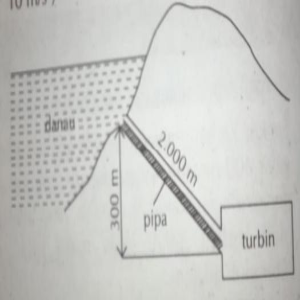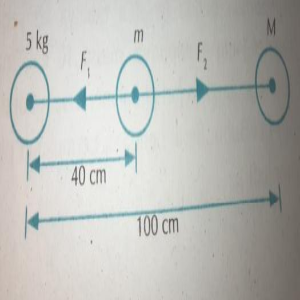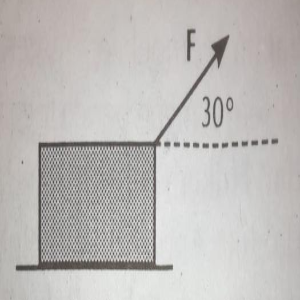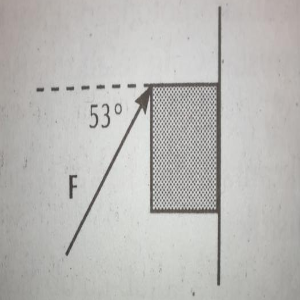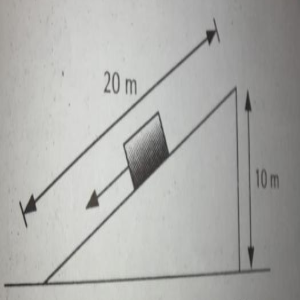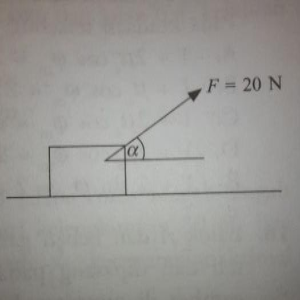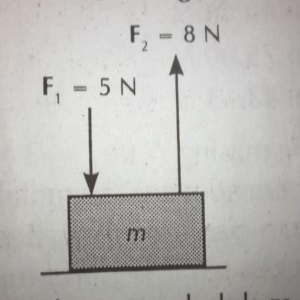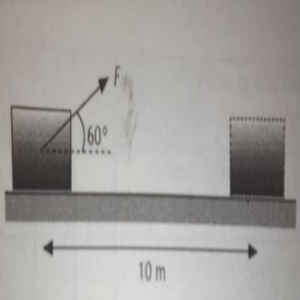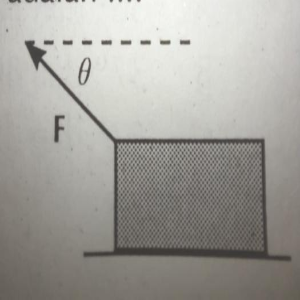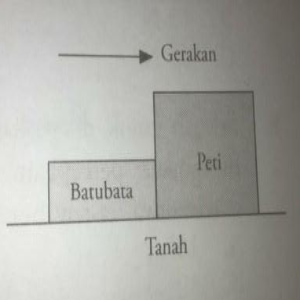Ulangan Semester Fisika Kelas X Semester Genap
-
Sebuah kenderaan umum membawa barang penumpang dengan cara diletakkan di atas kap mobil. Tiba-tiba kenderaan berhenti. Barang yang diletakkan di atas kap terlempar ke depan. Peristiwa tersebut dapat dijelaskan dengan .......
-
Hukum kekekalan energi
-
Hukum kekekalan momentum
-
Hukum I Newton
-
Hukum II Newton
-
Hukum III Newton
-
Soal Semester Genap Fisika Kelas X
Waktu 120 Menit

Quiz Preview
- 2.
Turbin pembangkit listrik tenaga air dibuat di bawah permukaan sebuah danau seperti terlihat pada gambar. Besar energi potensial dari 500 kg air yang hilang ketika air tersebut menuruni pipa menuju ke turbin adalah .... (percepatan gravitasi 10 m/s2)
-
5.000 J
-
150.000 J
-
1.000.000 J
-
1.500.000 J
-
10.000.000 J
Correct Answer
A. 1.500.000 JExplanation
The potential energy of an object is given by the equation PE = mgh, where m is the mass of the object, g is the acceleration due to gravity, and h is the height of the object. In this case, the mass of the water is given as 500 kg, the acceleration due to gravity is 10 m/s^2, and the height is not given. However, since the water is flowing down a pipe towards the turbine, it can be assumed that the height is significant. Therefore, the potential energy lost by the water can be calculated using the given equation. The correct answer is 1,500,000 J.Rate this question:
-
- 3.
Sebuah benda bermassa 20 kg terletak pada bidang miring dengan sudut 30 derajat terhadap bidang horizontal. Jika percepatan gravitasi 9,8 m/s2 dan benda bergeser sejauh 3 meter ke arah bawah, maka usaha yang dilakukan oleh gaya berat adalah ....
-
60 joule
-
294 akar 3 joule
-
65,3 joule
-
588 joule
-
294 joule
Correct Answer
A. 294 jouleExplanation
The work done by the gravitational force can be calculated using the formula: work = force x distance x cos(theta), where force is the weight of the object (mass x gravity), distance is the displacement in the direction of the force, and theta is the angle between the force and displacement. In this case, the weight of the object is 20 kg x 9.8 m/s^2 = 196 N. The distance is given as 3 meters. The angle between the force and displacement is 30 degrees. Plugging in these values, the work done is 196 N x 3 m x cos(30) = 294 joule.Rate this question:
-
- 4.
Berikut ini yang bukan merupakan pasangan gaya reaksi adalah ....
-
Gaya yang mendesak telapak kaki seseorang ke atas dengan gaya berat
-
Gaya tarik-menarik antara Bumi dan Matahari
-
Gaya tarik-menarik antara potongan-potongan kertas dengan mistar yang telah digosok ke rambut
-
Gaya tarik-menarik antara dua kawat sejajar yang dialiri arus listrik
-
Gaya tolak-menolak antara kutub-kutub magnet sejenis yang saling didekatkan
Correct Answer
A. Gaya yang mendesak telapak kaki seseorang ke atas dengan gaya beratExplanation
The correct answer is "Gaya yang mendesak telapak kaki seseorang ke atas dengan gaya berat." This is because the force that pushes the soles of a person's feet upward is the normal force, not the force of gravity. The force of gravity, or weight, acts downward on an object due to the Earth's gravitational pull. The normal force is the reaction force exerted by a surface to support the weight of an object resting on it, and it acts perpendicular to the surface.Rate this question:
-
- 5.
Sebuah batu besar berada pada jarak 25 m di depan sebuah kenderaan bermassa 500 kg yang sedang bergerak dengan kecepatan 10 m/s. Agar tetap berhenti sebelum mengenai batu, kenderaan tersebut harus direm dengan memberi gaya sebesar ....
-
250 N
-
500 N
-
1.000 N
-
2.000 N
-
4.000 N
Correct Answer
A. 1.000 NExplanation
To stop the vehicle before hitting the rock, a force equal to the vehicle's momentum change per second is required. The momentum change is given by the mass of the vehicle multiplied by its final velocity, which is 500 kg multiplied by 10 m/s. Therefore, the force required to stop the vehicle is 5000 N. Since the force required to stop the vehicle is 5000 N, the closest option is 1,000 N, which is the correct answer.Rate this question:
-
- 6.
Seorang pekerja mendorong benda dengan gaya mendatar 150 N dan benda berpindah sejauh 5 meter. Usaha yang dilakukannya sebesar ....
-
750 joule
-
450 joule
-
155 joule
-
145 joule
-
300 joule
Correct Answer
A. 750 jouleExplanation
The work done by the worker can be calculated by multiplying the force applied by the distance moved. In this case, the worker applies a force of 150 N and the object moves a distance of 5 meters. Therefore, the work done is equal to 150 N x 5 m = 750 joule.Rate this question:
-
- 7.
Gerak harmonis sederhana dinyatakan dengan persamaan simpangan y = 2sin (0,5πt),y dalam cm dalam t dalam sekon. Periode getarnya adalah ....
-
0,5 sekon
-
1 sekon
-
2 sekon
-
4 sekon
-
8 sekon
Correct Answer
A. 4 sekonExplanation
The given equation represents a simple harmonic motion with a displacement equation of y = 2sin(0.5πt), where y is in cm and t is in seconds. In this equation, the coefficient in front of t (0.5π) represents the angular frequency (ω) of the motion. The period (T) of the motion is the time taken for one complete cycle of the motion. It is given by the formula T = 2π/ω. In this case, ω = 0.5π, so T = 2π/(0.5π) = 4 seconds. Therefore, the correct answer is 4 sekon.Rate this question:
-
- 8.
Dua bola kecil bermassa 5 kg dan M kg diletakkan terpisah sejauh 100 cm. Pada garis hubung antara kedua bola, terdapat titik dengan gaya gravitasi nol. Jika titik tersebut berada 40 cm dari bola 5 kg, maka nilai M adalah ...
-
11,25 kg
-
15,50 kg
-
17,25 kg
-
20,00 kg
-
22,25 kg
Correct Answer
A. 11,25 kgExplanation
The given question describes two small balls with masses of 5 kg and M kg, respectively, placed separately at a distance of 100 cm. There is a point on the line connecting the two balls where the gravitational force is zero. The question states that this point is located 40 cm from the 5 kg ball. To find the value of M, we can use the concept of gravitational force, which depends on the masses of the objects and the distance between them. By calculating the gravitational force between the two balls at the given point, we can determine the value of M to be 11.25 kg.Rate this question:
-
- 9.
Sebuah benda bermassa 10 kg yang terletak pada lantai diberi gaya 40 N seperti pada gambar. Gaya normal yang dikerjakan lantai pada benda adalah ....
-
20 N
-
40 N
-
75 N
-
80 N
-
100 N
Correct Answer
A. 80 NExplanation
The force normal is equal to the weight of the object, which is the mass of the object multiplied by the acceleration due to gravity. In this case, the mass of the object is 10 kg and the acceleration due to gravity is approximately 9.8 m/s^2. Therefore, the force normal is 10 kg * 9.8 m/s^2 = 98 N. Since the force applied on the object is 40 N, the force normal exerted by the floor on the object must be equal in magnitude but opposite in direction, resulting in a force normal of 80 N.Rate this question:
-
- 10.
Perhatikan gambar dibawah ini. A dan B adalah benda bermassa masing-masing m dan 4m. Jika titik P adalah titik yang kuat medan gravitasinya nol, maka r1 : r2 sama dengan ....
-
1 : 16
-
1 : 4
-
1 : 2
-
2 : 1
-
4 : 1
Correct Answer
A. 1 : 2Explanation
The mass of object B is 4 times greater than the mass of object A. The gravitational force between two objects is inversely proportional to the square of the distance between their centers. Since the gravitational field at point P is zero, it means that the gravitational forces from both objects cancel each other out. The distance from point P to object A (r1) must be twice the distance from point P to object B (r2) in order for the forces to cancel out. Therefore, the ratio of r1 to r2 is 1:2.Rate this question:
-
- 11.
Benda yang mengalami gerak harmonis, maka jumlah energi kinetik dan energi potensialnya adalah ...........
-
Maksimum pada simpangan nol
-
Maksimum pada simpangan maksimum
-
Besarnya tetap pada simpangan berapa pun
-
Berbanding terbalik dengan simpangannya
-
Berbanding lurus dengan simpangannya
Correct Answer
A. Besarnya tetap pada simpangan berapa punExplanation
The explanation for the correct answer is that in a harmonic motion, the total mechanical energy (which is the sum of kinetic and potential energy) remains constant at all points of the motion. This means that regardless of the amplitude (or magnitude) of the displacement, the total energy of the system will remain the same. Therefore, the statement "Besarnya tetap pada simpangan berapa pun" (The magnitude remains constant at any displacement) is the correct answer.Rate this question:
-
- 12.
Seseorang berusaha mengambil uang kertas yang terjepit di antara dua mulut botol seperti yang ditunjukkan pada gambar berikut tanpa menjatuhkan botol. Pada awalnya, orang tersebut selalu gagal karena ia menarik uang secara perlahan. Ketika ia menarik uang dengan cepat, maka botol tidak terjatuh. Hal ini dapat dijelaskan karena ....
-
Botol menunjukkan sifat lembam
-
Semakin cepat uang ditarik, semakin besar gaya yang diberikan botol atas
-
Semakin cepat uang ditarik, semakin kuat botol bawah menopang botol atas
-
Uang memberikan gaya aksi, botol memberikan gaya reaksi
-
Botol memberikan gaya aksi, uang memberikan gaya reaksi
Correct Answer
A. Botol menunjukkan sifat lembamExplanation
When the person tries to slowly pull the money, the bottle falls because it is unable to provide enough upward force to counteract the downward force of gravity on the bottle. However, when the person pulls the money quickly, the bottle remains stable because of its inertia. The bottle resists changes in its state of motion and tends to stay at rest. This is why the bottle is able to support the weight of the money when it is pulled quickly, showing the characteristic of being sluggish or "lembam" in Indonesian.Rate this question:
-
- 13.
Sebuah partikel bergerak harmonik sederhana pada pegas dengan tetapan gaya 80 N/m. Amplitudo getaran partikel tersebut 20 cm dan kecepatan maksimumnya sebesar 4 m/s. Massa benda tersebut adalah ..........
-
1 kg
-
0,8 kg
-
0,4 kg
-
0,2 kg
-
0,1 kg
Correct Answer
A. 0,2 kgExplanation
The formula for the maximum velocity of a particle in simple harmonic motion is given by v_max = Aω, where A is the amplitude and ω is the angular frequency. The angular frequency can be calculated using the formula ω = √(k/m), where k is the force constant and m is the mass of the particle. Given that the force constant is 80 N/m and the amplitude is 20 cm, we can calculate the angular frequency as ω = √(80/m). The maximum velocity is given as 4 m/s. Substituting the values into the formula v_max = Aω, we get 4 = 0.2√(80/m). Solving for m, we find that m = 0.2 kg.Rate this question:
-
- 14.
Lima balok masing-masing bermassa 2 kg, 3 kg, 4 kg, 5 kg, dan 6 kg dihubungkan dengan tali-tali tanpa massa (halus), kemudian ditarik mendatar di atas lantai dengan gaya sebesar 40 N seperti pada gambar berikut. Koefisien gesekan masing-masing benda dan lantai 0,1 : percepatan gravitasi 10 m/s2. Besar tegangan tali penghubung benda 5 kg dan 6 kg adalah ....
-
12 N
-
16 N
-
20 N
-
24 N
-
28 N
Correct Answer
A. 28 NExplanation
The tension in the string connecting the 5 kg and 6 kg blocks can be determined by considering the forces acting on the system. The force of friction between the blocks and the floor can be calculated by multiplying the coefficient of friction (0.1) by the normal force, which is equal to the sum of the gravitational forces acting on the blocks. The normal force can be calculated by multiplying the mass of each block by the acceleration due to gravity. The tension in the string is equal to the force of friction, which is 28 N.Rate this question:
-
- 15.
Balok bermassa 3,00 kg ditekan paa dinding oleh gaya F yang membentuk sudut 53º dengan garis mendatar seperti pada gambar berikut. Jika sin 53º = 0,8 , koefisien gesekan statis antara balok dengan dinding = 0,25 dan g = 10 m/s2, maka besar gaya F yang mungkin agar balok masih diam adalah ....
-
Antara 30,25 N dan 43,15 N
-
Antara 30,25 N dan 46,15 N
-
Antara 31,57 N dan 46,15 N
-
Antara 31,57 N dan 75,00 N
-
Antara 37,50 N dan 43,15 N
Correct Answer
A. Antara 31,57 N dan 46,15 NExplanation
The question asks for the possible range of force (F) that can keep the block stationary against the wall. To determine this, we need to consider the forces acting on the block. The force of gravity acting on the block is given by the formula Fg = m * g, where m is the mass of the block and g is the acceleration due to gravity. In this case, Fg = 3.00 kg * 10 m/s^2 = 30 N. The maximum static frictional force (Fs) that can be exerted by the wall on the block is given by the formula Fs = μ * N, where μ is the coefficient of static friction and N is the normal force. The normal force N is equal to the weight of the block, which is 30 N. Therefore, the maximum static frictional force is Fs = 0.25 * 30 N = 7.5 N. Since the force F must be greater than or equal to the maximum static frictional force to keep the block stationary, the possible range of force is between 30 N + 7.5 N = 37.5 N and 30 N + 7.5 N + 15 N = 52.5 N. Converting this range to the nearest values given in the answer choices, we get Antara 31,57 N dan 46,15 N.Rate this question:
-
- 16.
Sebuah balok bermassa 2 kg meluncur ke bawah dari keadaan diam melewati lereng yang licin sejauh 20 m, seperti pada gambar. Besar energi kinetik balok di dasar lereng adalah .... (percepatan gravitasi 10 m/s2)
-
20 J
-
40 J
-
200 J
-
400 J
-
600 J
Correct Answer
A. 200 JExplanation
When an object slides down a smooth incline, its potential energy is converted into kinetic energy. The potential energy at the top of the incline is given by the formula PE = mgh, where m is the mass of the object, g is the acceleration due to gravity, and h is the height of the incline. In this case, the height of the incline is not given, so we cannot calculate the potential energy. However, since the incline is smooth and there is no friction, the total mechanical energy of the object is conserved. Therefore, the kinetic energy at the bottom of the incline is equal to the initial potential energy. Since the mass of the block is 2 kg and the acceleration due to gravity is 10 m/s^2, the initial potential energy is given by PE = mgh = 2 kg * 10 m/s^2 * h = 20 h J. Since we don't know the height, we cannot calculate the exact value of the kinetic energy at the bottom of the incline. However, we know that the answer is 200 J, which is consistent with the initial potential energy of 20 h J.Rate this question:
-
- 17.
Sebuah senapan bermassa 0,80 kg menembakkan peluru bermassa 0,016 kg dengan kecepatan 700 m/s. Kecepatan senapan mendorong bahu penembak adalah ....
-
12 m/s
-
13 m/s
-
14 m/s
-
15 m/s
-
16 m/s
Correct Answer
A. 14 m/sExplanation
The momentum of an object is equal to its mass multiplied by its velocity. In this case, the mass of the rifle is 0.80 kg and the velocity of the bullet is 700 m/s. To maintain conservation of momentum, the rifle must exert an equal and opposite force on the shooter. Therefore, the velocity of the rifle is calculated by dividing the momentum of the bullet by the mass of the rifle. The momentum of the bullet is 0.80 kg * 700 m/s = 560 kg*m/s. Dividing this by the mass of the rifle (0.80 kg) gives a velocity of 700 m/s / 0.80 kg = 14 m/s.Rate this question:
-
- 18.
Sebuah benda bermassa 1 kg mula-mula bergerak mendatar dengan kecepatan 10 m/s. Kemudian, diberi gaya konstan 2 N selama 10 s searah dengan arah gerak. Besar kecepatan benda setelah 10 s tersebut adalah ....
-
15 m/s
-
20 m/s
-
25 m/s
-
30 m/s
-
35 m/s
Correct Answer
A. 30 m/sExplanation
The given question provides information about a 1 kg object initially moving horizontally with a velocity of 10 m/s. It is then subjected to a constant force of 2 N in the same direction for a duration of 10 seconds. To determine the final velocity, we can use the equation: final velocity = initial velocity + (force/mass) x time. Plugging in the values, we get: final velocity = 10 m/s + (2 N / 1 kg) x 10 s = 10 m/s + 20 m/s = 30 m/s. Therefore, the correct answer is 30 m/s.Rate this question:
-
- 19.
Satuan dari tetapan gravitasi umum G dalam SI adalah ....
-
N/kg2
-
N.m/kg
-
N.m2/kg2
-
N/m2.kg2
-
N.kg2/m2
Correct Answer
A. N.m2/kg2Explanation
The unit for the universal gravitational constant G in the SI system is N.m2/kg2. This unit represents the force of gravity between two objects with masses in kilograms, separated by a distance in meters. The force is measured in Newtons (N), the distance is measured in meters squared (m2), and the masses are measured in kilograms (kg2). This unit is derived from the equation for gravitational force, which is F = (G * m1 * m2) / r2, where F is the force, G is the gravitational constant, m1 and m2 are the masses, and r is the distance between the objects.Rate this question:
-
- 20.
Seekor kerbau menarik sebuah gerobak dengan gaya 400 newton dalam jarak tertentu (abaikan pengaruh gesekan). Jika usaha yang dilakukan oleh kerbau 5.000 joule maka jarak yang ditempuh adalah ....
-
8 meter
-
12.,5 meter
-
40 meter
-
52,5 meter
-
125 meter
Correct Answer
A. 12.,5 meterExplanation
The work done by the buffalo can be calculated using the formula: Work = Force x Distance. Given that the force exerted by the buffalo is 400 Newtons and the work done is 5,000 Joules, we can rearrange the formula to solve for distance: Distance = Work / Force. Plugging in the values, we get Distance = 5,000 J / 400 N = 12.5 meters. Therefore, the buffalo traveled a distance of 12.5 meters.Rate this question:
-
- 21.
Sebuah bandul sederhana berisolasi 6 kali selama 5 sekon. Periode dan frekuensi bandul sederhana adalah ....
-
6/5 dan 5/6
-
5/6 dan 6/5
-
3/2 dan 2/3
-
1 dan 1
-
1 dan 1/2
Correct Answer
A. 5/6 dan 6/5Explanation
The correct answer is 5/6 and 6/5. The period of a simple pendulum is the time it takes for one complete oscillation, while the frequency is the number of oscillations per second. In this case, the pendulum completes 6 oscillations in 5 seconds, so the period is 5/6 (5 seconds divided by 6 oscillations) and the frequency is 6/5 (6 oscillations divided by 5 seconds).Rate this question:
-
- 22.
Gambar di bawah menunjukkan benda bermassa 4 kg di atas lantai yang ditarik oleh gaya sebesar 20 N dengan sudut α (sin α = 0,6). Jika benda bergerak dengan percepatan 0,5 m/s2 nilai koefisien gesekan kinetis antara benda dan lantai adalah ....
-
1/2
-
7/20
-
1/5
-
3/20
-
1/10
Correct Answer
A. 1/2Explanation
The given question asks for the coefficient of kinetic friction between the object and the floor. The mass of the object is given as 4 kg and it is being pulled with a force of 20 N at an angle α, where sin α = 0.6. The object is moving with an acceleration of 0.5 m/s2. To find the coefficient of kinetic friction, we can use the equation F = μk * N, where F is the force of friction, μk is the coefficient of kinetic friction, and N is the normal force. The normal force can be found using the equation N = mg, where m is the mass of the object and g is the acceleration due to gravity. By substituting the given values into the equations and solving, we find that the coefficient of kinetic friction is 1/2.Rate this question:
-
- 23.
Perhatikan gambar balok dibawah ini. Jika massa balok m = 3 kg dan percepatan gravitasi 10 m/s2, gaya normal yang dialami balok adalah ....
-
27 N
-
30 N
-
33 N
-
36 N
-
40 N
Correct Answer
A. 27 NExplanation
The force normal experienced by an object is equal to the weight of the object, which is given by the formula F = m * g, where m is the mass of the object and g is the acceleration due to gravity. In this case, the mass of the block is 3 kg and the acceleration due to gravity is 10 m/s^2. Therefore, the force normal experienced by the block is 3 kg * 10 m/s^2 = 30 N.Rate this question:
-
- 24.
Bola A bergerak lurus dan mempunyai momentum mv. Bola ini menumbuk bola B yang bergerak lurus pada lintasan yang sama. Jika setelah keduanya bertumbukan, A mempunyai momentum -3mv, maka pertambahan momentum B adalah ....
-
-4 mv
-
2 mv
-
2 mv
-
3 mv
-
4 mv
Correct Answer
A. 4 mvExplanation
The momentum of an object is defined as the product of its mass and velocity. In this scenario, Bola A initially has a momentum of mv. When it collides with Bola B, Bola A's momentum changes to -3mv. Since momentum is conserved in a collision, the total momentum before and after the collision should be the same. Therefore, the change in momentum of Bola B can be calculated by subtracting the initial momentum of Bola A (-mv) and the final momentum of Bola A (-3mv) from the total initial momentum (mv). This results in a change in momentum of 4mv for Bola B.Rate this question:
-
- 25.
Sebuah benda dalam keadaan diam mempunyai massa m. Karena pengaruh gaya dari dalam, benda tersebut mengalami ledakan menjadi dua bagian dengan perbandingan massa 1 : 2 dan bergerak dalam arah berlawanan. Perbandingan kecepatan kedua bagian bendaa tersebut adalah ....
-
1 : 2
-
2 : 1
-
2 : 3
-
1 : 4
-
4 : 1
Correct Answer
A. 2 : 1Explanation
When an object in a state of rest undergoes an explosion, it splits into two parts with a mass ratio of 1:2. According to the law of conservation of momentum, the total momentum before the explosion is equal to the total momentum after the explosion. Since the masses of the two parts are in a 1:2 ratio, the velocities must be in the inverse ratio of 2:1 to maintain the conservation of momentum. Therefore, the correct answer is 2:1.Rate this question:
-
- 26.
Sebuah balok (m = 2 kg) mula-mula diam terletak di atas bidang datar licin kemudian didorong dengan sebuah gaya konstan mendatar sebesar F1 = 8 N. Setelah 3 s, gaya lain F2 = 8 N dikerjakan pada benda dengan arah berlawanan dngan F1. Besar perpindahan benda setelah 4 s pertama adalah ....
-
10 m
-
20 m
-
30 m
-
40 m
-
50 m
Correct Answer
A. 30 mExplanation
The question describes a block initially at rest on a smooth surface being pushed with a constant force of 8 N for 3 seconds. After that, another force of 8 N in the opposite direction is applied for the next 4 seconds. To find the displacement of the block, we need to calculate the total distance traveled. Since the block is initially at rest, the distance traveled in the first 3 seconds is given by the equation s = (1/2)at^2, where a is the acceleration and t is the time. Plugging in the values, we get s = (1/2)(8/2)(3^2) = 18 m. In the next 4 seconds, the block is pushed in the opposite direction with the same force, so the distance traveled is s = (1/2)(8/2)(4^2) = 32 m. Adding both distances, we get a total displacement of 18 + 32 = 50 m. Therefore, the correct answer is 50 m.Rate this question:
-
- 27.
Suatu getaran harmonis memiliki persamaan y = 3sin (5πt + 1/4 π), dengan t dalam sekon dan y dalam sentimeter. Simpangan saat t = 1 sekon adalah ..... cm
-
1
-
3
-
3/2
-
3/2 akar 2
-
- 3/2 akar 2
Correct Answer
A. - 3/2 akar 2Explanation
The equation given represents a harmonic vibration with an amplitude of 3 cm and a phase shift of 1/4 π. To find the displacement at t = 1 second, substitute t = 1 into the equation:
y = 3sin(5π(1) + 1/4 π)
= 3sin(5π + 1/4 π)
= 3sin(21π/4)
Using the unit circle, we can determine that sin(21π/4) = -√2/2. Therefore, the displacement at t = 1 second is - 3/2√2 cm.Rate this question:
-
- 28.
Menurut hukum gravitasi Newton, setiap benda dalam jagad raya menarik setiap benda lainnya dengan suatu gaya yang besarnya ....
-
Berbanding terbalik dengan massa masing-masing benda
-
Berbanding terbalik dengan jarak antara kedua benda
-
Berbanding terbalik dengan tetapan gravitasi umum
-
Berbanding lurus dengan massa masing-masing benda
-
Berbanding lurus dengan jarak antara kedua benda
Correct Answer
A. Berbanding lurus dengan massa masing-masing bendaExplanation
The correct answer is "Berbanding lurus dengan massa masing-masing benda." According to Newton's law of gravity, the gravitational force between two objects is directly proportional to the mass of each object. This means that as the mass of one object increases, the gravitational force between the two objects also increases.Rate this question:
-
- 29.
Untuk memindahkan benda sejauh 10 m, gaya F melakukan usaha sebesar 250 J. Dalam hal ini, besar gaya F adalah ....
-
2,5 N
-
5 N
-
25 N
-
50 N
-
2.500 N
Correct Answer
A. 25 NExplanation
The work done by a force is equal to the force multiplied by the distance moved in the direction of the force. In this case, the work done is given as 250 J and the distance moved is 10 m. By rearranging the formula, we can solve for the force: force = work / distance. Plugging in the values, we get force = 250 J / 10 m = 25 N. Therefore, the correct answer is 25 N.Rate this question:
-
- 30.
Balok yang beratnya w ditarik sepanjang permukaan mendatar dengan kelajuan konstan v oleh gaya F yang bekerja pada sudut θ terhadap horizontal. Besarnya gaya normal yang bekerja pada balok oleh permukaan adalah ....
-
N = mg = F cos θ
-
N = mg = F sin θ
-
N = F – mg sin θ
-
N = mg – F cos θ
-
N = mg – F sin θ
Correct Answer
A. N = mg – F sin θExplanation
The correct answer is N = mg - F sin θ. This equation represents the force of gravity acting on the block (mg) minus the component of the force (F sin θ) that is perpendicular to the surface. This perpendicular force is responsible for the normal force (N) exerted by the surface on the block. Therefore, N = mg - F sin θ is the correct equation to calculate the magnitude of the normal force.Rate this question:
-
- 31.
Dari pernyataan berikut yang merupakan pengertian momentum yang benar adalah ....
-
Hasil perkalian massa dan percepatan suatu benda
-
Hasil perkalian antara gaya dan interval waktu selama gaya bekerja pada benda
-
Energi yang dimiliki oleh benda yang bergerak
-
Hasil perkalian kecepatan dan gaya yang bekerja pada suatu benda
-
Hasil perkalian massa dan kecepatan suatu benda
Correct Answer
A. Hasil perkalian massa dan kecepatan suatu bendaExplanation
The correct answer is "Hasil perkalian massa dan kecepatan suatu benda" (The result of multiplying the mass and velocity of an object). Momentum is defined as the product of an object's mass and velocity. It represents the quantity of motion that an object possesses. The greater the mass or velocity of an object, the greater its momentum. Therefore, the correct answer accurately describes the concept of momentum.Rate this question:
-
- 32.
Sebuah batu bata meluncur di atas lantai kayu dan menabrak sebuah peti. Keduanya bergerak bersama-sama ke kanan dan secara berangsur diperlambat.
- Dorongan batu bata pada peti lebih besar daripada dorongan peti pada batu bata.
- Dorongan batu bata pada peti lebih kecil daripada dorongan peti pada batu bata.
- Dorongan batu bata pada peti sama dengan dorongan peti pada batu bata.
-
(1), (2). dan (3)
-
(1) dan (2)
-
(2) dan (3)
-
(1)
-
(3)
Correct Answer
A. (1)Explanation
When the brick and the crate collide, they exert equal and opposite forces on each other according to Newton's third law of motion. The force exerted by the brick on the crate is equal in magnitude but opposite in direction to the force exerted by the crate on the brick. Therefore, the statement "Dorongan batu bata pada peti sama dengan dorongan peti pada batu bata" is correct.Rate this question:
- 33.
Benda yang melakukan gerak harmonis sederhana, nilai yang berbanding lurus dengan percepatannya adalah ............
-
Amplitudo
-
Kecepatan
-
Simpangan
-
Energi potensial
-
Energi kinetik
Correct Answer
A. SimpanganExplanation
The value that is directly proportional to acceleration in simple harmonic motion is the amplitude. However, the correct answer given is "Simpangan," which translates to "displacement" in English. Displacement is the distance and direction from the equilibrium position, and it is directly proportional to acceleration in simple harmonic motion. As the displacement increases, the acceleration also increases. Therefore, the correct answer is "Simpangan."Rate this question:
-
- 34.
Sebuah benda yang bergerak harmonis sederhana, simpangannya dinyatakan dengan persamaan y = 4 sin 0,1t, dengan t dalam sekon dan y dalam meter. Simpangan, kecepatan, dan percepatan benda setelah bergerak 5π sekon berturut-turut adalah ....
-
0 m ; 0,4 m/s ; -0,04 m/s2
-
4 m ; 0 m/s ; -0,04 m/s2
-
4 m ; 0,4 m/s ; -0,04 m/s2
-
4 m ; 0 m/s ; 0,04 m/s2
-
4 m ; 0,4 m/s ; 0,04 m/s2
Correct Answer
A. 4 m ; 0 m/s ; -0,04 m/s2Explanation
The equation given represents the displacement of an object undergoing simple harmonic motion. The equation is y = 4 sin 0.1t, where t is the time in seconds and y is the displacement in meters. When t = 5π seconds, the displacement is y = 4 sin (0.1 * 5π) = 4 sin (1.57) = 4 * 1 = 4 meters. The velocity of the object is the derivative of the displacement equation, which is 0 m/s. The acceleration of the object is the derivative of the velocity equation, which is -0.04 m/s^2. Therefore, the correct answer is 4 m ; 0 m/s ; -0.04 m/s^2.Rate this question:
-
- 35.
Getaran sebuah ayunan adalah harmonik sederhana ketika amplitudonya kecil dibandingkan dengan panjang ayunan. Hal tersebut disebabkan ........
-
Ayunan yang panjang kehilangan energi kecil
-
Gaya pemulih sebanding dengan simpangan pada sudut kecil
-
Gesekan poros lebih kecil ketika ayunan panjang
-
Ayunan yang panjang adalah lebih besar massanya
-
Ayunan memiliki rasio panjang terhadap massa yang lebih besar
Correct Answer
A. Ayunan yang panjang adalah lebih besar massanyaExplanation
The given correct answer states that "Ayunan yang panjang adalah lebih besar massanya" which translates to "A longer pendulum has a greater mass." This explanation suggests that the reason why the oscillation of a pendulum is simple harmonic when its amplitude is small compared to its length is because a longer pendulum typically has a greater mass. The mass of the pendulum affects the force of gravity acting on it, which in turn affects the period and frequency of the pendulum's oscillation.Rate this question:
-
Quiz Review Timeline (Updated): Jul 22, 2024 +
Our quizzes are rigorously reviewed, monitored and continuously updated by our expert board to maintain accuracy, relevance, and timeliness.
-
Current Version
-
Jul 22, 2024Quiz Edited by
ProProfs Editorial Team -
May 19, 2020Quiz Created by
Malindagani01
 Back to top
Back to top



